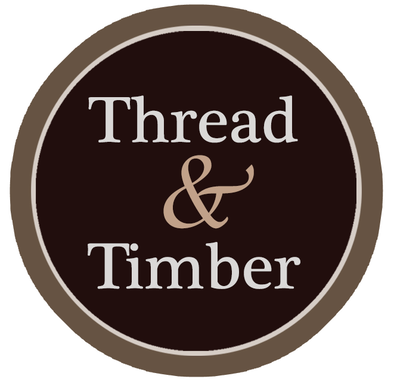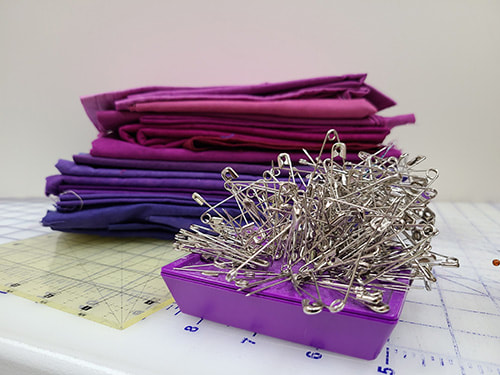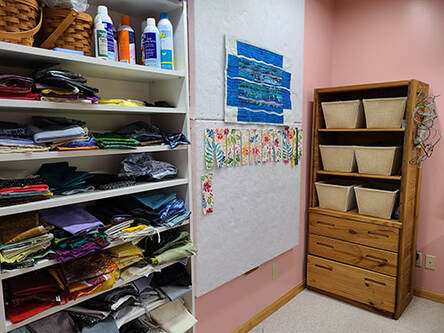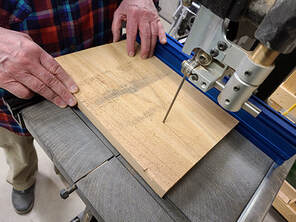New to the Thread & Timber Collection
Botanical
|
The winter months of 2023 seemed to call for light colors and organic shapes. We could imagine we were walking along a garden path and seeing a graceful vine attempting to climb the trellis instead of heading outdoors to shovel more snow!
The approximate size is 32" tall and 24" at the widest point. It protrudes 7" from the wall. The framework is painted in a metallic copper. Contact us for purchase information. |
|
Celebration!
|
Yes, we are celebrating with this one. After 6 months of garage demolition, construction of a new garage and shop for Bill, moving in and setting up equipment… ”Timber” is back to work! We never imagined it would take this long so the first quilt completed in the new workshop can’t be anything BUT a celebration. Luckily Barb (“Thread”) spent a good share of the winter turning out quilts for him to complete. The fabric is in bright shades of pink and purple and it includes some felted wool appliques. Needle felting helped fill the long winter of ‘22/’23. Size: 33 inches high and 20 inches wide at the longest points.
Contact us for purchase information. |
|
Tree of Life
|
When you reach the point in life where the years you’ve been on this planet exceed the years you have left, you realize that being a branch on the family tree is much less of a gift than becoming part of the roots. This piece is dedicated to our children’s children and their children too. Let’s work to keep their planet safe. Size: 26 inches high, 35 inches wide.
Contact us for purchase information. |
|
Hope
|
Always seek the sun hiding behind the rainclouds of life. An intricate form shows off the silver lining behind each individually styled and hand-quilted cloud. This piece is a tribute to optimism! Size: Roughly 20 inches by 20 inches. It protrudes 4 ½ inches from the wall at its highest point.
Contact us for purchase information. |
|
View the rest of the Thread & Timber collection!
Thread & Timber Featured in Vendor Blog
AquaCoat manufactures the eco-friendly water-based wood finish we use on our projects. They recently featured Thread & Timber on their blog! Click the button below to read the post.
About Thread & Timber
About Thread & Timber
|
At Thread & Timber, we stand for COLLABORATION! We are all stronger when we work together, whether we are part of a nation, a community, a family….or even a marriage. Our art is a collaboration between Barb (Thread), a long-time quilter and Bill (Timber), a retired engineer and emerging woodworker. One of us is improvisational, one analytical. Our strengths combined, create a more dynamic whole.
After retirement we pursued hobbies and volunteer activities. Barb’s 20 year interest in quilting gradually morphed into a passion for improvisational art quilts. |
Bill set up a workshop and tried to determine what to build. The chance suggestion from a close friend, “Why don’t you have Bill make a frame for that quilt?” was the inspiration we needed. It turns out he had an innate sense of design, an interest in making quilts more dimensional and the engineering skills to make it happen. The fabric scraps and the wood scraps have been flying ever since! We hope you will enjoy following us on this, our newest collaboration.
Scroll down to learn more about Thread & Timber's design approach or explore our pages to see our work. |
�
Barb a.k.a ThreadI started out as a traditional quilter in 1993. While that’s not an absolutely necessary path to becoming an art quilter, I personally think it’s a good thing to sharpen one’s basic skills in the beginning. Art quilting is all about breaking the rules and it’s good to know the rules first so you end up with a quilt that actually stays together. The folks at SAQA (Studio Art Quilt Association of which I am a member) define an art quilt as “artwork made of fiber that has been layered and quilted in some manner”. That gives plenty of room for interpretation! Most of what I create still follows the norm as a traditional quilt that has been pieced, but in an improvisational manner. I love improv quilting! I don’t like to follow a pattern and I don’t like to complete quilt square after square until it covers a bed. Frankly, I don’t like to measure things either. I am the exact opposite of my analytical husband which apparently allows us to work well together as long as we stay out of each other’s way.
|
|
My inspiration almost always starts with fabric. Like most quilters, I have a little fabric “problem”. (We try not to say “hoarder”). Most of the time I purchase fabric with no notion of where it will end up eventually but instead, choose colors and designs that catch my eye along with a good supply of solids or nearly solids. My most important tool (other than a working sewing machine) is a design board. I start by hanging up different fabrics and seeing how well they play together. I generally have a vague notion of what the quilt might look like but rarely put that plan on paper and it’s likely to migrate through different concepts before I’m finished.
|
|
Once I’ve put the whole thing together with batting and backing, it’s time to finalize the quilting plan. Quilting is what gives a quilt texture and interest. Plus, it holds everything together which is one of those important basic elements I spoke of earlier. I know some quilters have someone else complete the actual quilting but I find doing it myself makes me feel like it’s really my own work. Plus, I love the quilting process itself…either by machine or especially by hand… but quite often a combination of both. Not mixing the two is one of those rules that were made to be broken. My quilting is never perfect. Probably it’s my less-than-perfect nature but I think it’s what gives a piece character. That’s my story and I’m sticking to it!
|
Think of the great things that could happen in our world if each of us offered our strengths and worked together! Thread & Timber
Bill a.k.a TimberThread says: In the past year I’ve had the pleasure of handing off the finished product to Bill (aka “Timber”) who views the quilt in an entirely different way than I do. Being partially color blind seems to help him focus on design more than color. I’ve learned that if I give him suggestions on what I think should happen, it generally doesn’t turn out as well as when I let him run with the design. It’s at that point I give up total ownership and it becomes OUR work. I think there might be some life lessons here somewhere.
|
Timber says: I apply “dimensional form/s” to continue the visual series and theme presented by Thread. Using “Pickup Sticks (COVID Quilt)” as an example, the grain line in the wood blocks parallels lines in the quilt somewhere. The top surfaces of the blocks are staggered to add dimension to the form.
The dimensional forming process starts by tracing the outline of the quilt on to graph paper. The quilt is analyzed for series and theme/s that can be continued in the form dimensionally. Ideas are roughed out onto the tracing until a design concept formulates.
Then detail drawings are made of each of the form pieces. Part of this process utilizes the “ometries” (Trig, Ge, and Descriptive Ge) while blatantly disregarding symmetry and level lines. A career in engineering was spent constrained by the latters, so it is nice to be rid of them for a while. It is more fun to be outside the box than in!
Then detail drawings are made of each of the form pieces. Part of this process utilizes the “ometries” (Trig, Ge, and Descriptive Ge) while blatantly disregarding symmetry and level lines. A career in engineering was spent constrained by the latters, so it is nice to be rid of them for a while. It is more fun to be outside the box than in!







